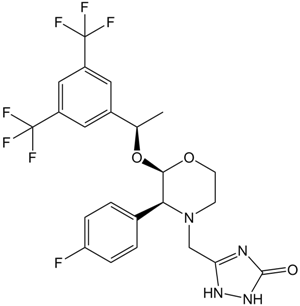Aprepitant (Synonyms: Emend, L754,030, MK-869, ONO7436) |
| Catalog No.GC15200 |
L'aprépitant (MK-0869) est un antagoniste sélectif et de haute affinité des récepteurs de la neurokinine 1 avec un Kd de 86 pM.
Products are for research use only. Not for human use. We do not sell to patients.

Cas No.: 170729-80-3
Sample solution is provided at 25 µL, 10mM.
Aprepitant (also known as MK-0869) is a novel and highly selective Neurokinin-1 (NK-1) receptor antagonist that inhibits the activity of substance P (SP), an undecapeptide belonging to the tachykinin family of peptides, on the NK-1 receptor with the dissociation constant Kd of 86 pM for human NK-1 receptor and the half maximal inhibition concentration IC50 of 0.1 nM, 4 nM and 0.7 nM for human, rat and ferret NK-1 receptors respectively [1,2].
Since SP has been demonstrated to induce cell proliferation in several human cancer cell lines with overexpressed NK-1 receptors, aprepitant has also been found to concentration-dependently induce growth inhibition in a variety of tumor cell lines, including glioma (GAMG), neuroblastoma (SKN-BE2, IMR-32 and KELLY), retinoblastoma (Y-79 and WERI-Rb-1), pancreas carcinoma (PA-TU-8902 and CAPAN-1), larynx carcinoma (HEp-2), gastric carcinoma (23132-87) and colon carcinoma (SW-403), with IC50 of 33.1 μΜ, 24.6 μΜ, 19.6 μΜ, 27.7 μΜ, 30.4 μΜ, 23 μΜ, 31.2 μΜ, 27.4 μΜ, 22.7 μΜ, 24.2 μΜ and 30.5 μΜ respectively [2].
References:
[1] Tattersall FD1, Rycroft W, Cumberbatch M, Mason G, Tye S, Williamson DJ, Hale JJ, Mills SG, Finke PE, MacCoss M, Sadowski S, Ber E, Cascieri M, Hill RG, MacIntyre DE, Hargreaves RJ. The novel NK1 receptor antagonist MK-0869 (L-754,030) and its water soluble phosphoryl prodrug, L-758,298, inhibit acute and delayed cisplatin-induced emesis in ferrets. Neuropharmacology. 2000 Feb 14;39(4):652-63.
[2] Muñoz M1, Rosso M. The NK-1 receptor antagonist aprepitant as a broad spectrum antitumor drug. Invest New Drugs. 2010 Apr;28(2):187-93. doi: 10.1007/s10637-009-9218-8. Epub 2009 Jan 17.
Average Rating: 5 (Based on Reviews and 22 reference(s) in Google Scholar.)
GLPBIO products are for RESEARCH USE ONLY. Please make sure your review or question is research based.
Required fields are marked with *




















